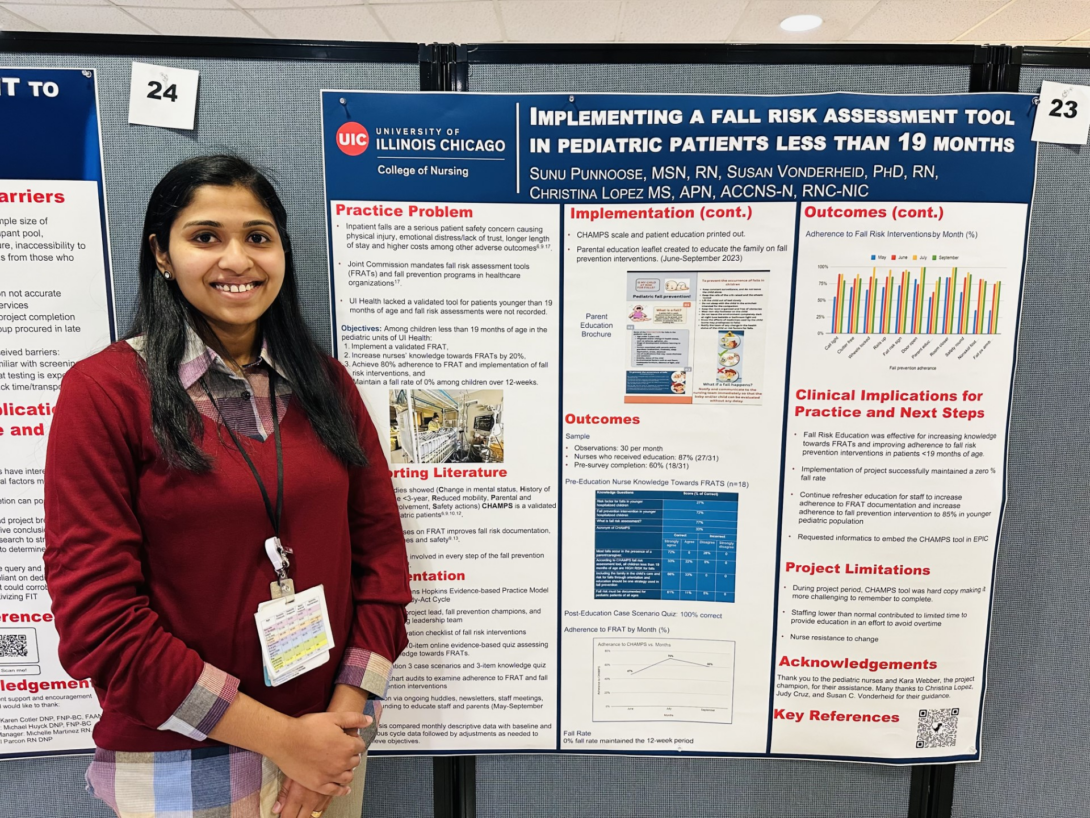Pediatric fall risk assessment
Sunu Punnoose, RN Heading link

Project: Implementation of a fall risk assessment tool in pediatric patients less than 19 months of age.
Setting: Pediatric unit, University of Illinois, May-September, 2023
Project Team: Sunu Punnoose, MSN, RN, (UIN CON student), Susan Vonderheid, PhD, RN, (Faculty mentor), Christina Lopez MS, APN, ACCNS-N, RNC-NIC (practice mentor).
Introduction: Inpatient falls are a serious patient safety concern causing physical injury, emotional distress/lack of trust, longer length of stay and higher costs among other adverse outcomes. Joint Commission mandates fall risk assessment tools (FRATs) and fall prevention programs in healthcare organizations. UI Health lacked a validated tool for patients younger than 19 months of age and fall risk assessments were not recorded. The objectives of the project were to implement a validated FRAT, increase nurses’ knowledge and attitudes towards FRATs by 20% and achieve 80% adherence to FRAT and implementation of fall risk interventions, and maintain a fall rate of 0% among hospitalized children less than 19 months of age over a 12-week period.
Background: A literature search was conducted to assess the risk factors for falls and identify a validated fall risk assessment tool in younger children. CHAMPS is a validated FRAT in younger children. Educating nurses on evidence-based FRAT can improve fall risk documentation, enhance patient outcomes and safety while minimizing harm. Children and caregivers must both be involved in every step of the fall prevention interventions.
Process: By using the Johns Hopkins Evidence-based Practice Model and Plan-Do-Study-Act Cycle, a team with project lead, fall prevention champions, and pediatric nursing leadership was created. Pre-post observations of fall risk interventions and Pre-education 10-item online evidence-based quiz assessing nurses’ knowledge towards FRATs were performed. Educated the staff and parents via ongoing huddles, newsletters, staff meetings, and rounding. Post-education consisted of 3 case scenarios and 3-item knowledge quiz. Ongoing chart audits done to examine adherence to FRAT and fall risk prevention interventions. Analysis compared monthly descriptive data with baseline and previous cycle data followed by adjustments as needed to achieve objectives. CHAMPS scale and patient education printed out and parental education leaflet created to educate the family on fall prevention interventions.
Results and conclusions: There was a significant improvement in the RN documentation regarding fall prevention interventions compared to the baseline data. 0% fall rate was maintained throughout the project period. Fall Risk Education was effective for increasing knowledge/attitudes towards FRATs and adherence to interventions
Recommendations: Compliance with fall prevention measures allowed the unit to improve its quality metrics by reducing the fall associated injuries and length of hospital stay. Request to Nursing informatics to embed the CHAMPS tool in EPIC. Continue refresher education to staff on fall prevention intervention in younger pediatric population.